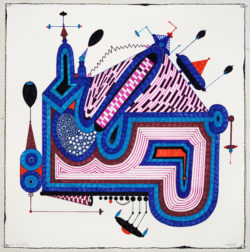Luis Cruz Azaceta
Cuban-born New Orleans artist Luis Cruz Azaceta creates monumental assemblages of barricades and photo constructions of urban blight, representing both hope and decay within American culture.

Courtesy of Arthur Roger Gallery
Shifting States-Tunisia. Azaceta, Luis Cruz (artist)
The Cuban-born New Orleans artist Luis Cruz Azaceta explores a dark side of America in his work. His monumental assemblages of barricades and photo constructions of urban blight—representing both hope and decay within American culture—reflect his continuing ambiguity toward his adopted homeland.
Born in Havana on April 5, 1942, Azaceta’s journey to New Orleans began in 1960 when his family fled Cuba following Fidel Castro’s communist revolution. Azaceta and his family settled in New York City, where he studied art at the School of Visual Arts and eventually became a critically acclaimed figure in the city’s contemporary art scene and a pioneer in the New Expressionist movement. In the early 1980s, he served a brief stint as a visiting artist at Louisiana State University in Baton Rouge, where he met Sharon Jacques, a young graduate art student with a studio adjacent to his. They married, moved to New York, and in 1992, relocated to New Orleans with their two sons. “I wanted to raise my sons in the South and her family was here in New Orleans,” said Azaceta. “I’ve always loved New Orleans.” He felt a special cultural connection between his native Havana and New Orleans.
Once in New Orleans, Azaceta experimented with his art and for the first time used photography and photo-collages to explore the city. Even his application of paint changed in New Orleans. “I began to incorporate images of New Orleans,” he said. “They are not as expressionistic as they were in New York.” Traveling about the city with his camera helped him “to get into the culture of the city.”
While Azaceta’s art, especially earlier works that dealt with urban violence and AIDS in New York, tended to demand gut reactions from viewers, his earliest artistic output in New Orleans seemed almost passive and reflective, like stanzas from unrelated poems. Two large constructions started in New York but completed in New Orleans, Barricade and Borderline, had more to do with promise than denial. Barricade is a dark and somber reminder of the Berlin Wall. A black wooden ladder leans against the canvas. A small window cut through the wall reveals blue skies and sunshine on the other side. For those who live on the fringes of the American Dream, the ladder was hope, a means of transcendence, and the window promised a better life on the other side.
In an unrelated 1999 series titled Back Streets, Azaceta shot photographs of street scenes in blighted New Orleans neighborhoods and mounted them on wood panels to create sobering depictions of urban decay. In his 1997 assemblage Poydras 1, the artist captured an almost Mondrianesque symmetry of boarded-up windows in an ordinary nineteenth-century New Orleans townhouse about to be demolished. In other photographs he shot art on paint-chipped walls of dilapidated riverfront warehouses with scenes reminiscent of the action paintings of the 1950s. These photo assemblages reveal Azaceta’s curiosity about his new home, especially the effect of long semitropical summers on New Orleans’s aging architecture.
Like most artists living in New Orleans before and after Hurricane Katrina in 2005, Azaceta responded to the tragedy in his 2007 series Local Anesthesia. There was nothing anesthetic about these works. Rather than easing pain, they graphically reminded viewers of great suffering. In the mixed media paintings N.O. Pool and New Orleans Flood, Azaceta drowned the city in pools of black water. And in his drawing Head Watch, a crazed and frantic face emerges from the side of a television set broadcasting scenes of houses and trees being washed away. His compelling photo-collages True Value: 9th Ward and Katrina Debris spoke to the hundreds of lives lost and thousands of homes destroyed. Here he pieced together photographs of lifeless neighborhoods, wrecked houses, churches and mountains of felled trees, building materials and the remnants of people’s everyday lives.
Perhaps the most poignant work in this effort was At the Bottom of the Pot, a series of color photographs of storm destruction and survivors wading through floodwaters to safety. Mounted to the bottoms of metal pots and pans (a nod to the city’s culinary eminence), the photographs show the faces of the “bottom-of-the-pot” poor, elderly, or infirm people who could not or did not evacuate the city before the storm struck. He captured their struggle to survive.
Azaceta’s subsequent work, however, reflected an artist still living in an emotional labyrinth between life in exile in an adopted land and fading memories of his native Havana. That suspension between memories and reality becomes clear in his most recent autobiographical series, Swimming to Havana and Exile 50. With a bold polychromatic palette, Azaceta explored real and metaphysical questions of exile, displacement, alienation, and longings for a pre-Castro Cuba that exists only in his memories. In both series, he created deceptively whimsical and almost playful labyrinths painted in tension-creating counterpoints of color and form as devices to portray this dichotomy between his life in exile and the past.
Azaceta has gained critical success with major shows in galleries and museums in New Orleans, Miami, New York City, Sacramento, the Dominican Republic, Panama, and Mexico. In early 2010, the New Orleans Museum of Art featured his paintings in a solo show. In addition, he has received numerous honors, grants, and fellowships, including those from the National Endowment for the Arts, Guggenheim Foundation Fellowship, New York Foundation for the Arts, and the Joan Mitchell Foundation. His work can be found in public and private collections worldwide, including New York City’s Museum of Modern Art, Metropolitan Museum of Art, and Whitney Museum of American Art; Boston’s Museum of Fine Arts; the New Orleans Museum of Art; and many others in the United States, Central and South America, Australia, and Europe.
